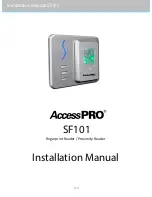
31
13 | Frequently Asked Questions
What is a Wireless LAN?
A local area network that transmits over the air typically in an unlicensed frequency such as the
2.4GHz band. A wireless LAN does not require lining up devices for line of sight transmission like IrDA.
Wireless access points (base stations) are connected to an Ethernet hub or server and transmit a ra-
dio frequency over an area of several hundred to a thousand feet which can penetrate walls and other
non-metal barriers. Roaming users can be handed off from one access point to another like a cellular
phone system. Laptops use wireless network cards that plug into an existing PCMCIA slot or that are
self contained on PC cards, while stand-alone desktops and servers use plug-in cards (ISA, PCI,
etc.).
What is AD-HOC?
An AD-HOC network is a peer to peer network where all the nodes are wireless clients. As an exam-
ple, two PC’s with wireless adapters can communicate with each other as long as they are within
range. A wireless extension point can extend the range of an AD -HOC network.
What is the 802.11 standard?
A family of IEEE standards for wireless LANs first introduced in 1997. 802.11 provides 1 or 2 Mbps
transmission in the 2.4GHz band using either a frequency hopping modulation (FHSS) technique or
direct sequence spread spectrum (DSSS), which is also known as CDMA. The 802.11b standard d e-
fines an 11 Mbps data rate in the 2.4GHz band, 802.11g -draft standard defi nes 54 Mbps in the
2.4GHz band, and the 802.11a standard defines 54 Mbps in the 5GHz band.
What is Infrastructure?
In order for your wireless components to interact with traditional wired networks they need a media
bridge to translate for them. This is where INFRASTRUCTURE or Network mode comes into play. An
ACCESS POINT is attached to the network using CAT -5 Ethernet cable attaching to a hub, switch or
another PC. Wireless PC’s can then communicate to Wired Ethernet computers through this access
point. The total range of the network is limited to a radius around this Access Point. To increase the
range, extra Access Points may be wired into the network. These Access Points talk to each other
over the hard-wired Ethernet cables however, they cannot communicate wirelessly to one another and
they must be wired to the same network. Individual wireless PC’s can move between Access Points
on the same network seamlessly due to a feature called ROAMING.
What is Tx Rate?
Tx-Rate or TRANSFER RATE is the current speed at which the network component is operating.
SMC -802.11b products can operate at speeds of 1Mb, 2Mb, 5.5Mb, & 11Mbps. A wireless card set to
AUTO will attempt to connect at whatever speed will give the best throughput on the network.
What is RTS Threshold?
(Request To Send) An RS-232 signal sent from the transmitting station to the receiving station re-
questing permission to transmit. RTS is a collision avoidance method used by all 802.11b wireless
networking devices. In most cases you will not need to acti vate or administer RTS. Only if you find
yourself in an Infrastructure environment where all nodes are in range of the Access Point but may be
out of range of each other. It is recommended to leave this setting at its default value leaving this fe a-
ture disabled.
What is Authentication Algorithm?
Authentication Algorithm is the means by which one station is authorized to communicate with a nother.
In an Open System, any station can request authorization in accordance with the WECA sta ndard. In
a Shared key system, only stations that possess a secret encrypted key may participate in the net-
work. This is a low level security key which allows the equipment with the shared key alg orithm to see
each other on the wireless lan.
Summary of Contents for 2512W-B FICHE
Page 1: ...SMC2512W B EU...
Page 6: ...5...






































